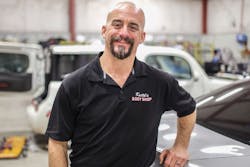When body technician Terry Chamberlain checks his mailbox each morning, he doesn’t find bills or advertisements or magazines. He finds a repair order.
To clarify, Chamberlain isn’t at home; he is at work. And this isn’t just any mailbox; this mailbox exemplifies a system owner Scott Chase has perfected over the past five years at Keith’s Body Shop in North Platte, Neb.
Chamberlain knows when his mailbox is full because a small LED light shines above it in bright red. That light is turned on by manager/estimator Jamie Piper, who leaves her office in a separate building, walks a couple hundred feet down Rodeo Road, heads into another building, drops off Chamberlain’s latest assignment and a parts rack, flips on that light, and walks away without saying a single word.
Less than 10 minutes later, Chamberlain flips the light off, opens his mailbox, and finds a folder containing everything he needs to get started: the vehicle’s repair order number, the name of the customer, the estimator assigned to the vehicle, a list of parts, and the expected date-out for the job.
As soon as Chamberlain is done with his repairs, he’ll walk into the paint and prep building and mimic what Piper did earlier. And from prep to paint to detail, and so on and so forth, until the keys are returned to the vehicle owner’s hands, the staff at Keith’s Body Shop will work perfectly in sync—likely without having to speak to one another about the job.
It might not be for everyone, but for Chase, nonverbal communication is the key to mastering efficiency during the repair process.
“Nonverbal communication is imperative,” Chase says. “Everything is lost in interpretation. If it’s not written down, it’s not true.”
100 Percent Workflow
When Jim Anderson walked into Keith’s Body Shop, he couldn’t believe it.
Anderson is a consultant at Management Success!, and Chase, always craving to improve shop efficiency, had reached out for advice on his repair process.
Chase was “pretty green” when he decided to enter the collision repair industry. Before taking over Keith’s Body Shop in 2010, he had a history in managing hotels, where procedure is key. From check-in to customer service to cleaning to check out, a system of established practices between various departments keeps operations running smoothly and customers up-to-date and satisfied.
“It all came very naturally to me,” Chase says of transitioning into collision. “I wanted to create a relaxed atmosphere and really focus on improving efficiency.”
Starting out in a 4,620-square-foot building, Chase grew the business into two more neighboring buildings on the same block, where various stages of the repair process are housed. While he originally envisioned moving operations into one building, he’s actually discovered no flaws with separating the departments. If anything, it has aided achieving nonverbal communication.
“These guys can move a vehicle and never say a word,” he says. “It’s beautiful.”
His system has been five years in the making, and it’s not done evolving yet. Every week, Chase says his SOP boards—which rest alongside the mailboxes in each department—are updated with new policies aimed at eliminating verbal communication and making the process more efficient.
The results? Three buildings staffed with eight employees combining for an average monthly car count of 48 and annual revenue of $1.4 million. Over the past four years, cycle time has improved by 2 to 3 days. Chase’s labor costs have dropped from 35 to 18 percent; parts costs are down from 32 to 21 percent; and paint and materials costs went from 10.5 to 6.1 percent.
And one more stat from Anderson: 100 percent workflow.
“It’s the only inspection I’ve ever done where everything was exactly the way it should be,” he says. “You’d think being spread over three buildings would make it challenging, but everything is so clearly identified and organized that the shop just functions flawlessly.”
The Nonverbal Process
The Layout
To understand the intricacies of Chase’s nonverbal system, the three-building layout should be overviewed.
Building One: 4,000 square feet; staffs two body technicians, two estimators, one owner; houses office, estimating, blueprinting and parts departments, and two bays for collision.
Building Two: 2,600 square feet; staffs one technician; houses one bay for frame work.
Building Three: 4,620 square feet; staffs one painter and one detailer; houses prep, polish, paint and detail departments, and paint booths.
The Meeting
Every morning at 9 a.m., Keith’s Body Shop’s eight employees gather in the main office. This meeting—which lasts no longer than 10 minutes—is crucial for ensuring nonverbal communication throughout the day.
On two white boards, Chase lists the in- and out-dates for all current repair orders and discusses the reports from the previous day.
“They know exactly where that vehicle is at during entire process,” he says. “I’ll lay out the weekly schedule on Monday, and for the rest of the week, they’ll know exactly which vehicles are coming out on which days.”
The Repair
The estimator takes a pre-check-in sheet and examines the vehicle damage. This document, referred to as the (1) quality control (QC) sheet at Keith’s, is the first, integral piece of the nonverbal repair process. Stashed in a hanging repair order protector attached with a string, it contains the repair order number, customer information, the employees assigned to the vehicle, the date-in and expected date-out, and all parts to be used for the vehicle.
The QC sheet moves into the parts department, where parts are listed and piled onto a (2) parts rack. While the car travels from department to department, building to building, the QC sheet will accompany it and the parts rack. At no point will those three items be separated.
As the car and parts rack move between departments, the QC sheet is either put inside or hung from an employee’s (3) mailbox—each labeled with the department name—and the (4) red light is flipped on.
According to standard operating procedures, the employee has 10 minutes to retrieve the QC sheet and turn the light off. Everyone knows this because, in each department, there is a (5) red board that lists the (6) SOPs for various stages in the repair process: check-in, refinishing panels, refinishing plastic, prepping, polishing, parts check-in, etc.
The SOPs visually lay out, through (7) charts and images, the steps for administering a “quality inspection.” Each employee must initial that he or she completed a quality inspection on the QC sheet, as well as check off that each part is accounted for at that station. Because of their ubiquity, these quality control instructions have nearly eliminated comeback customers, Chase says.
“We have lots of visual stuff,” Chase says. “Body guys are extremely visual. They see things and can work through things in ways other people can’t.”
There are even SOPs and QC check-offs for the company Keith’s sublets glass repairs out to.
“They go to their board, do their work, have the technician sign off on the vehicle so that it passes through our final QC, and then they put the bill right in the folder and flip on the light so we know we can move ahead.”
Each board also contains a (8) “Work Flow Quality Control Diagram,” which lists every stage in the repair process so the employee knows where the vehicle should travel next: office, parts, disassembly, repair, prep, paint, polish, reassembly, etc.
In the prep area, Chase set up (9) dry erase boards that list every vehicle that needs to be primed alongside each repair order number.
“He can go to one area in the prep shop and see everything and categorize it according to out dates,” he says. “It’s his responsibility to prioritize each job every single day.”
Before the keys are returned to the customer, the vehicle is transferred over to the detail department, where the board looks a little different. Hanging above each mailbox is a (10) paper clock, which Scott or his manager rotates to relay when the vehicle must be completed (the clock system is used for the pre-wash in the polishing department as well).
You can guess what happens next: The car is detailed, the QC sheet is checked and initialed, returned to the original building and hung from the manager’s final QC board, and the light is flipped on. The manager then performs a final quality control before handing the keys back to the customer.
A Core Group
Establishing this system over the past few years hasn’t been easy. Chase says he lost over 20 employees who balked at his goal for a nonverbal system.
“You get guys that are unwilling, who can’t see how, down the road, this is going to help,” he says. “They want to fight and argue because it’s not the way they did it in this or that shop. Those attitudes don’t work.”
To find the right employees, Chase implemented a four-step interview process spread out over several days. If they are on board with the nonverbal system, their fourth interview is a total submersion into Keith’s repair process.
“Once they walk the shop and get a firsthand look, they want to be here and part of the team,” he says. “Once a new person is hired … within three months they have a fantastic understanding.”
Chase eventually formed a core group that has worked under the system for three-and-a-half years now. And as he tinkers with processes and makes them more cohesive, that staff will only get more efficient with each passing day.
“I joke because I don’t talk to these guys anymore,” he says. “I say hello to them in the morning and then I might not see them until 5 p.m. when they leave. They know their job. They’re professionals, and they know exactly what to do. It’s perfect.”

